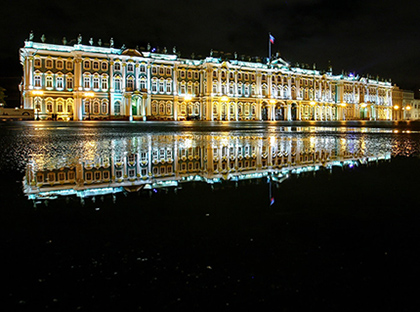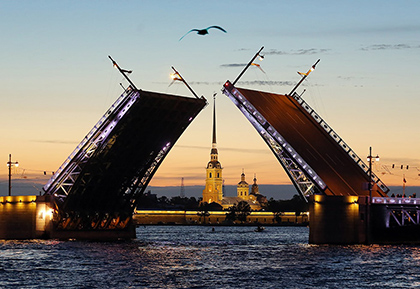
St. Petersburg is a relatively young city, with a little over three hundred years of history. However, in these centuries of rapid growth and development, St. Petersburg has forged its own path, evolving into a timeless city, inimitable in its beauty and harmony. It is elusive and enigmatic, a truly unique city in Russia's history. For more than 200 years, it was the resplendent capital of the great Russian Empire, and remains the country's cultural and spiritual centre to this day.

St. Petersburg was founded on May 16, 1703, by order of the Russian Emperor, Peter the Great. For the first ten years of its history the town was developed as a fortress and sea port, but a brisk trade soon transformed the city into a centre of economic prosperity, industry and craftsmanship. It was during this time that the famous Alexander Nevsky Monastery was founded, and this city on the banks of the Neva became renowned as a religious centre. In 1710 the royal family relocated here from Moscow, bringing the Tsarist palace and government offices with them and making St. Petersburg the capital of the Russian Empire. For a short time during the rule of Peter II (1727-1730), the capital moved back to Moscow, but St. Petersburg regained its status as Russia's most important city three years later.
Peter the Great's youngest daughter, Elizabeth I, continued her father's work. During her rule, vast numbers of wooden structures were torn down and replaced with stone. It was Elizabeth who gave Bartolomeo Rastrelli the chance to shine here, and St. Petersburg was soon graced with stunning palaces and cathedrals which, even two and a half centuries on, rank among St. Petersburg's most grandiose and spectacular architecture. The Winter Palace, the great palaces at Tsarskoe Selo, Smolny Cathedral, and Smolny Convent were all erected during this time. The Tsarina was a patron of both science and the arts, and two leading universities—Moscow State University and the Russian Academy of Arts—were founded under her initiative. In fact, Mikhail Lomonosov, the great scientist, writer and polymath, owes much of his success to Elizabeth I.
During the reign of Catherine II ‘The Great’ (1729-1796) people began calling the city ‘Magnificent Petersburg’. The Winter Palace, the Admiralty, Nevsky Prospect, the granite embankments along the rivers and canals, and the Bronze Horseman, that famous statue of Peter the Great, were all built while she was on the throne.

These advances in St. Petersburg’s development were stunted by the Napoleonic invasion. Nonetheless, during this period the Mikhailovsky Palace, the Alexandrinsky Theatre, and the Senate and Synod were built; the construction of Palace Square was completed; and the ground was broken for the construction of St. Isaac's Cathedral.
Even before the start of the 20th century, St. Petersburg had become a truly European city—a centre of both industry and culture.
In 1914 St. Petersburg was renamed Petrograd, partly as a response to WWI and the general anti-German feelings of the time.
Three years later Petrograd became the setting for the dramatic events of 1917, and in 1918, at the beginning of the ‘Red Terror', the city ceded capital status to Moscow. Even so, in 1918 and 1919 Petrograd made many advances, including the creation of the film studio now known as Lenfilm, the opening of the famous ‘Dom Knigi’ book shop, and the establishment of the ‘Vsemirnaya Literatura’ publishing house. After Lenin’s death, in 1924, the city was renamed Leningrad in honour of the revolutionary leader.
The Siege of Leningrad lasted from 1941 to 1944, 900 days during which the city was cut off from the rest of the world. However, the city endured and survived, and Leningrad’s resurrection out of its thoroughly bombed ruins was a feat of equal enormity to its initial foundation in the early 18th century. In 1944, at the end of the siege, there was not one significant monument untouched by shells or fire, and the rural palace estates lay in ruins. Yet by the middle of the 1950s, a mere 10 years after its destruction, Leningrad was restored and had already regained its status as a gem of world architecture and culture.
The city reverted to its original name, St. Petersburg, in 1991. St. Petersburg is now Russia's second most important economic, scientific and cultural centre after Moscow, and one of the most beautiful cities in the world.




